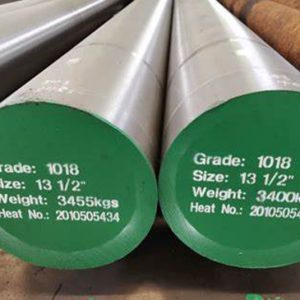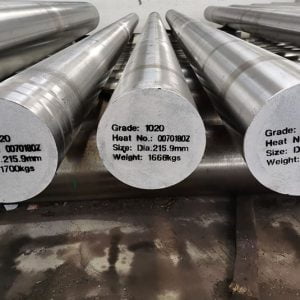Introduction
Steel is a fundamental material in many industries due to its versatility, strength, and durability. Among the various types of steel, 1018 steel is widely used because of its excellent balance of mechanical properties and ease of machinability. One of the most critical properties of 1018 steel is its yield strength, which determines its ability to withstand stress without undergoing permanent deformation. This article delves into the science behind 1018 steel yield strength, explaining its importance, influencing factors, and applications in various industries.
Understanding Yield Strength

Yield strength is a measure of the stress at which a material begins to deform plastically. Beyond this point, the material will not return to its original shape when the applied stress is removed. For 1018 steel, yield strength is a key indicator of its performance and suitability for different applications.
Table: Basic Mechanical Properties of 1018 Steel
| Property | Value |
|---|---|
| Yield Strength | 370 MPa (53,700 psi) |
| Ultimate Tensile Strength | 440 MPa (63,800 psi) |
| Elongation at Break | 15% |
| Modulus of Elasticity | 205 GPa |
| Density | 7.87 g/cm³ |
Factors Affecting 1018 Steel Yield Strength
The yield strength of 1018 steel is influenced by various factors, including its chemical composition, heat treatment processes, and manufacturing techniques. Understanding these factors can help optimize the material’s performance for specific applications.
Chemical Composition of 1018 Steel
1018 steel is a low-carbon steel, typically containing about 0.18% carbon, 0.75% manganese, and traces of other elements. The low carbon content contributes to its good weldability and machinability, while the manganese content helps improve its strength and hardness.
Heat Treatment Processes
Heat treatment processes such as annealing, normalizing, quenching, and tempering can significantly affect the yield strength of 1018 steel. These processes alter the microstructure of the steel, enhancing or reducing its mechanical properties.
- Annealing: Softens the steel, reducing yield strength but improving ductility.
- Normalizing: Refines the grain structure, balancing yield strength and toughness.
- Quenching and Tempering: Increases hardness and yield strength while maintaining some level of ductility.
Table: Heat Treatment Effects on 1018 Steel Yield Strength
| Heat Treatment Method | Yield Strength (MPa) | Description |
|---|---|---|
| Annealed | 210 | Softens the steel, reduces yield strength |
| Normalized | 370 | Refines grain structure, standard yield strength |
| Quenched and Tempered | 450 | Increases hardness and yield strength |
Manufacturing Techniques
The method of manufacturing, including processes such as hot rolling and cold drawing, can also impact the yield strength of 1018 steel. Cold drawing increases yield strength through work hardening, while hot rolling may result in a more uniform microstructure.
Grain Size
Grain size is another critical factor influencing the yield strength of 1018 steel. Finer grains generally enhance yield strength due to the grain boundary strengthening mechanism. Controlling the cooling rate during processing can help achieve the desired grain size.
Applications of 1018 Steel Based on Yield Strength
The yield strength of 1018 steel makes it suitable for a variety of applications across different industries. Here are some common uses where yield strength plays a crucial role:
Automotive Industry
In the automotive sector, 1018 steel is used for manufacturing components such as shafts, axles, and gears. The high yield strength ensures these parts can withstand significant stress and strain during operation, contributing to the overall durability and safety of vehicles.
Construction
1018 steel is widely used in the construction industry for building structures, bridges, and other infrastructures. Its yield strength allows it to support loads without permanent deformation, ensuring the stability and longevity of constructions.
Machinery Parts
For machinery parts like gears, bolts, and pins, 1018 steel is an excellent choice due to its balanced yield strength and machinability. These components often face repetitive stress and need to maintain their shape and integrity over time.
Tooling
In the tooling industry, 1018 steel is used to create jigs, fixtures, and other support tools. The material’s yield strength ensures these tools are durable and can withstand the mechanical loads they encounter during use.
How to Measure 1018 Steel Yield Strength
Accurate measurement of 1018 steel yield strength is essential for quality control and ensuring material performance. The most common method for measuring yield strength is through a tensile test.
Tensile Testing Procedure
Sample Preparation: A standardized sample of 1018 steel is prepared.
Loading: The sample is placed in a tensile testing machine, and a uniaxial force is applied.
Deformation Measurement: The stress and strain are recorded as the force is increased.
Yield Point Identification: The yield strength is identified as the point where the material begins to deform plastically.
The Microstructure of 1018 Steel
The microstructure of 1018 steel plays a significant role in determining its yield strength. The microstructure is influenced by the steel’s composition, heat treatment, and manufacturing processes.
Ferrite and Pearlite
1018 steel primarily consists of ferrite and pearlite. Ferrite is a soft, ductile phase, while pearlite is a harder, stronger phase composed of alternating layers of ferrite and cementite. The proportion of ferrite and pearlite in 1018 steel affects its mechanical properties, including yield strength.
Grain Structure
The grain structure of 1018 steel can be controlled through heat treatment and manufacturing processes. Fine-grained structures typically result in higher yield strength due to the grain boundary strengthening mechanism. Proper control of cooling rates during processing can help achieve the desired grain size.
Improving 1018 Steel Yield Strength

There are several techniques to enhance the yield strength of 1018 steel, making it more suitable for demanding applications.
Alloying
Adding alloying elements such as chromium, nickel, and molybdenum can improve the yield strength of 1018 steel. These elements form solid solutions and fine precipitates, hindering dislocation movement and increasing strength.
Work Hardening
Cold working processes, such as rolling and drawing, can increase the yield strength of 1018 steel through work hardening. This method involves deforming the steel at temperatures below its recrystallization temperature, which introduces dislocations and strengthens the material.
Heat Treatment
As previously discussed, heat treatment processes like quenching and tempering can significantly enhance the yield strength of 1018 steel. By controlling the temperature and cooling rate, it is possible to optimize the microstructure and mechanical properties of the steel.
Conclusion: 1018 Steel Yield Strength
Understanding the 1018 steel yield strength is essential for selecting the right material for various engineering and manufacturing applications. The yield strength determines how much stress the steel can withstand before permanently deforming, making it a crucial factor in ensuring the durability and reliability of the final product. By considering the factors that affect yield strength and following proper testing methods, you can optimize the use of 1018 steel for your specific needs. Whether you are involved in the automotive, construction, or machinery industry, knowing the science behind 1018 steel yield strength will help you make informed decisions, leading to successful and long-lasting projects.
FAQ
What is the typical yield strength of 1018 steel?
The typical yield strength of 1018 steel is around 370 MPa (53,700 psi). This value can vary slightly based on manufacturing processes and heat treatments.
How does heat treatment affect the yield strength of 1018 steel?
Heat treatment processes such as annealing, normalizing, quenching, and tempering can significantly alter the yield strength of 1018 steel. For example, quenching and tempering can increase the yield strength to around 450 MPa.
Can 1018 steel be used in high-stress applications?
Yes, 1018 steel can be used in high-stress applications, especially when it has been heat-treated to enhance its yield strength. Its balance of strength and ductility makes it suitable for components subjected to significant mechanical loads.
How does the composition of 1018 steel influence its yield strength?
The composition of 1018 steel, particularly its carbon content, directly influences its yield strength. Higher carbon content generally increases the strength and hardness of the steel.
What industries commonly use 1018 steel?
1018 steel is commonly used in the automotive, construction, machinery, and tooling industries due to its excellent balance of yield strength, ductility, and machinability.
What is the difference between yield strength and tensile strength?
Yield strength is the stress at which a material begins to deform plastically, while tensile strength is the maximum stress a material can withstand before breaking. For 1018 steel, the yield strength is typically 370 MPa, and the ultimate tensile strength is around 440 MPa.
How is yield strength measured in a laboratory?
Yield strength is typically measured using a tensile test. A standardized sample of 1018 steel is subjected to a uniaxial force in a tensile testing machine, and the stress and strain are recorded. The yield strength is identified as the point where the material begins to deform plastically.
Can yield strength of 1018 steel be increased by cold working?
Yes, cold working processes such as rolling and drawing can increase the yield strength of 1018 steel through work hardening. This method introduces dislocations and strengthens the material by deforming it at temperatures below its recrystallization temperature.
Why is yield strength important in engineering applications?
Yield strength is important because it determines the limit of stress a material can withstand without permanent deformation. This property is crucial for designing components that must maintain their shape and integrity under mechanical loads, ensuring safety and reliability in engineering applications.
What role does grain size play in the yield strength of 1018 steel?
Grain size plays a significant role in determining the yield strength of 1018 steel. Finer grains typically enhance yield strength due to the grain boundary strengthening mechanism. Controlling the cooling rate during processing can help achieve the desired grain size, optimizing the material’s mechanical properties.





